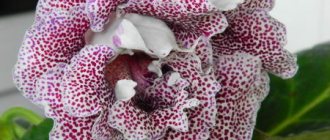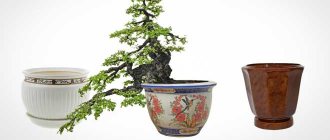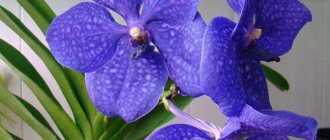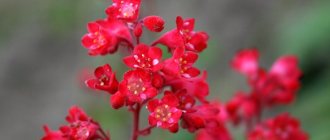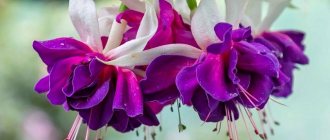How to grow "Queen's Earrings"
Growing this beautiful plant is not an easy task: the beauty is very sensitive and capricious. Breeding indoor fuchsia will require knowledge, time, and effort.
- Where to place it? Unless you live in a tropical or subtropical climate, a cool room in a very well-lit area is ideal. There should be sunlight most of the day, but not direct. At home, fuchsia feels great on windows facing east or west.
- Temperature. A resident of the subtropics reacts equally poorly to both low and high air temperatures. Desirable temperature limits for growing fuchsia indoors: 18-25°. At higher or lower temperatures, the plant stops forming buds, the foliage falls off, and growth slows down.
- Watering. From spring to autumn, especially during the flowering period, abundant watering is required: the soil should always be slightly moist. However, remember, due to excess moisture, the leaves fall off and the buds wither without opening. In hot summer weather or when the air in the house is too dry, the plant must be misted frequently to create a humid environment. Be careful: water should not get on the petals! From November to March, watering is reduced to the required minimum - once a week.
The best varieties of bush fuchsias
Maik Luijten – elongated lower petals of two shades: snow-white above, light red below. The skirt is dark lilac. Velvet flowers.
Lassie – lower petals dark beetroot. Snow-white velvet skirt. At first the flowers are large. If they bloom profusely and for a long time, they become a little smaller, but this does not make them less attractive. Very resistant to high temperatures and sun!
Kit Oxtoby – peach-colored lower petals with green edges. The skirt is purple-lilac with a border. Double flowers, very picturesque.
Jubie-Lin – closed peduncles of elongated shape. The lower petals are deep cherry. The skirt is dark purple-violet with a reddish border. The flowers are velvety, huge, the foliage is dark emerald.
Jomi Hemschoote – the lower petals are elongated and red. Skirt of the same color. The flowers are velvety and large.
Marlen Toika – the lower petals are soft white with a lilac-blue semi-velvet skirt. The flowers are big. They bloom very amicably and cover the entire bush.
Martinus is a rather rare pristine white flower color without the addition of pink. The lower flowers are snow-white with emerald edges. The velvet skirt is also white with a subtle shade of cream. With big flowers.
Medalist – the lower petals form a round shape. The flowers are pale pink. Peach skirt with white strokes. The flowers are velvety and large.
Michiels Lut – lower petals are white. The skirt is lilac with slightly pronounced pink-cream touches. The flowers are velvety and large.
Natasha Sinton – the lower petals form an elongated shape in pastel pink tones. The skirt is nice pink.
Nicola Claire – elongated red lower buds with a hot pink skirt. Velvety, large peduncles.
Niedersachsen – variegated red flowers with a skirt of white with red streaks. Intensely velvety large flowers.
Tatjana – velvety soft white-pink lower flowers with rich colors towards the edge of the petals and emerald sides. The skirt is the same pleasant white and pink color with a slightly darker tone at the base.
How to replant fuchsia correctly?
- The best time to move is early spring. At the beginning of the growing season, the immune system is strong enough to cope with any stress. And the adaptation of a flower transplanted in early spring is much faster. In winter, it is better not to touch the flower: even a simple move to a new place can destroy it.
- For picking or replanting, it is recommended to use a clay or ceramic flower pot. Natural material will reliably protect delicate roots from overheating. It should be large enough so that you don't have to replant the bush every year.
- Drainage is important. A drainage layer thickness of less than 3 cm does not guarantee against waterlogging of the soil.
- The soil. Good development and flowering can only be achieved using a substrate with a high humus content, enriched with organic compost. However, it should be slightly acidic, with a pH below 6.
- Fertilizers. During the spring and summer, it is recommended to fertilize the plants every two weeks by adding fertilizer to the irrigation water. From November to February, fertilizing is applied no more than once a month. To accelerate the formation of green mass, products with a high nitrogen content are needed. Blooming fuchsia needs feeding more than usual. And in order to create and maintain abundant flowering, compounds with a predominance of potassium and phosphorus are needed.
How does fuchsia reproduce?
Exotic propagates well by seeds and cuttings. Despite the fact that you can collect fuchsia seeds yourself at the end of the season, we do not recommend the seed method. It is so complex and unpredictable that it is best left to specialists. In addition, propagation by seeds does not completely preserve the characteristics of the mother variety. But reproduction by cuttings is a simple and hassle-free task.
You can cut and root cuttings at any time of the year, except winter. If cuttings are carried out in the autumn months, take care to provide the seedlings with sufficient light for 12-14 hours. Another condition for obtaining a guaranteed result: cut not young shoots, but semi-lignified branches. You can root cuttings either in a container with water or in a closed mini-greenhouse.
If the second option is chosen, peat and sand mixed in equal parts are used as soil. Two weeks after the appearance of root shoots, the seedling is transplanted to a permanent place of residence. The main recommendation for caring for rooted seedlings is no fertilizing for the first three weeks!
Ampelous fuchsias
This species has elongated elastic shoots. It looks great hanging. To form a chic cascade of flowers, 5-6 seedlings are placed in one pot. They are placed closer to the edge, slightly tilted, to immediately give the bush the desired shape. The cuttings are pinched above the 2-3rd pair of leaves, this gives the bush density. When the crown begins to form and the density of the bush suits you, leave the fuchsia to bloom.
If there is a need to give the bush more splendor, pinch it again above the second pair of leaves that have grown after the initial operation.
Small-flowered and non-double varieties will bloom earlier than large-flowered and velvety ones. Periodically turn flowerpots with hanging fuchsias with different sides towards the sun so that the crown is formed more evenly.
Fuchsia in winter
At this time, flowers are not watered more than twice a month. It is necessary to provide the necessary coolness for the rest period. The air temperature at this time of year should not be higher than +17°. If this is not done, fuchsia will not be able to rest and will enter the growing season considerably weakened. This will lead to a halt in development and even a lack of flowering.
No feeding required. They are needed only during the growing season for the formation of peduncle buds. But pruning fuchsia for the winter is not only desirable, but also mandatory. This is especially true for garden varieties grown in open ground.
Pests and diseases of fuchsia
Fuchsia in a pot is sensitive to attacks from whiteflies, mealybugs, aphids and mites. You should also be careful with soil-borne fungal mycobacteria, which dry out and weaken the leaves. Particularly large losses are possible in the case of so-called gray mold. Symptoms of infection:
- gray spots on the inside of the leaf,
- deformation of the edge of the sheet plate,
- wilting and necrosis of a large number of leaves and branches.
In all of the above cases, saving the bush can only be done with the help of systemic drugs (“Actellik”, “Angara” and others).
Bush varieties
They stand out with evenly growing, strong shoots. Depending on which variety you choose, a bush or a standard plant with a lush crown may grow.
Buy pots of light colors only. In hot sunshine, the soil in a small pot heats up very quickly, and if the container is dark, young, unhardened roots can simply “bake.”
The abundant variety of fuchsia has become the basis for new varieties and hybrids.
The most common bush fuchsia hybrids are:
Celia Smedley is a very common standard variety with pleasant snow-white flowers. The skirt is lilac, catchy. Forms numerous clusters.
Caspar Hause - blood-red flower stalks, with a velvety cherry skirt.
Coral Drops – deep pink flowers. The skirt is lemon red. The flowers are ordinary, forming numerous racemes. The leaf blade is green with a burgundy tint.
Cymon – the lower petals are a pleasant pink color, the skirt is the color of violet. It blooms with velvety large flowers generously and for a long time.
De Brommel - snow-white flowers with emerald edges. The skirt is very velvety, slightly elongated, purple in color.
Delta's Song - the lower petals are snow-white with emerald edges with a slightly noticeable cream coating. The skirt is purple. The flowers are ordinary, small, growing upward and to the sides. It blooms continuously, generously and for a long time.
Dulcie Elisabeth – velvety large flowers of dark pink color with emerald tips. The skirt has a light red top with blue streaks, and a lavender bottom.
Eureka Red - large blood-colored flowers, somewhat similar to peonies, their skirt is larger than the width of the petals! It blooms naturally, very long and generously. It is advisable to tie up the bush; due to the numerous flowers, the branches may break.
Gay Parasol - have a rare ivory color. The frill is deep lilac, lightening to pink over time. Huge flattened and velvety flowers look like an umbrella.
Graefin Elli Trautmannsdorf – pink-red flowers. The frill is a dark burgundy shade, huge and velvety flowers. Quite a picturesque variety.
Granada -dense beet flowers with greenish edges are very velvety and large in size. The skirt is burgundy with dark pink touches.
Huet's Labradoriet – flowers are elongated and large. The petals are soft pink with emerald edges. The skirt is violet with a pink tint, darkening to red over time. The flowers are large and densely velvety.
Jopie – purple skirt with red stripes. The flowers are velvety and large. A very variegated variety!
Kaleidoscop e – lower petals are dark red. The skirt varies in different shades of purple with red and pink touches. The flowers are velvety, very large. During flowering, the shape and color of the petals may change.
Lady in Gray – peduncles are velvety, large. The lower petals are white with an apricot coating inside. The skirt is soft lilac-blue. A very touching variety.
Lambada – blooms profusely, with small flowers with variegated lilac petals and a blue skirt that shower a small bush with leaves with tiny serrations. Great for bonsai.
Tom West is a densely flowering, self-branching fuchsia with regular small peduncles. The lower petals are cherry color, the skirt is violet with red strokes at the base. The small leaves are light green with a delicate cream edging. Petals with cherry-colored veins. In the sun, young leaves turn a peach color.
Varieties and types of fuchsia with photos
The genus Fuchsia includes 107 species. More than half of this list are residents of the tropics and subtropics of South America. The species diversity of the genus is amazing! There is everything here: from miniature shrubs to three-meter-high trees. We offer views with photos and descriptions of the most famous and spectacular ones.
- Fuchsia magellanica (Magellan) is one of the most unpretentious and cold-resistant species. This is a fairly tall deciduous shrub - up to 1.5 m in height. Used in garden design when decorating walls and for forming hedges.
- F. corymbiflora var. Alba is a spectacular cultivar with exquisite bells of a delicate lilac-white color. The homeland of the maternal species, on the basis of which the hybrid was bred, is the mountain slopes of Peru and Ecuador.
- Fuchsia Checkerboard is a variegated version obtained by crossing two species. Abundant branching gives a bush with dimensions of 90 x 90 cm. It is recommended for planting in open ground. If we are talking about central Russia, for the winter the bush is completely pruned and transferred to a cool room.

